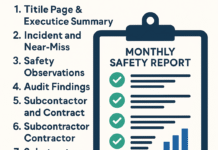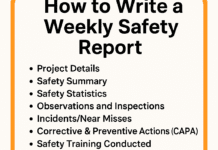
HSE Documents: Ensuring Safety and Compliance
In any organization, ensuring health, safety, and environmental (HSE) standards are met is paramount. HSE documents play a crucial role in achieving this goal by providing guidelines, procedures, and protocols to mitigate risks and maintain compliance. Let’s delve into the world of HSE documents, exploring their significance, types, creation process, implementation, and more.
Importance of HSE Documents
HSE documents serve as the foundation for establishing and maintaining a safe and healthy work environment. They outline organizational policies, procedures, and best practices aimed at preventing accidents, injuries, and environmental harm. By adhering to these documents, companies demonstrate their commitment to employee welfare, regulatory compliance, and environmental stewardship.
Types of HSE Documents
Policy Documents
Policy documents set forth the overarching principles and objectives of an organization’s health, safety, and environmental management system. They articulate management’s commitment to HSE excellence, define responsibilities, and establish the framework for HSE activities.
Procedures
Procedures provide step-by-step instructions for carrying out specific tasks or processes safely and efficiently. From emergency response procedures to equipment operation protocols, these documents ensure that employees understand how to perform their duties while minimizing risks.
Risk Assessments
Risk assessments identify and evaluate potential hazards in the workplace, assess the likelihood and severity of harm, and propose control measures to mitigate risks. By conducting thorough risk assessments, organizations can proactively identify and address safety and environmental concerns.
Incident Reports
Incident reports document workplace accidents, injuries, near misses, and environmental incidents. They capture essential details, such as the date, time, location, individuals involved, and the circumstances surrounding the event. Incident reports help organizations investigate incidents, identify root causes, and implement corrective actions to prevent recurrence.
Creating HSE Documents
Research and Preparation
Before creating HSE documents, organizations must conduct comprehensive research to understand relevant laws, regulations, industry standards, and best practices. This information serves as the foundation for developing effective HSE policies, procedures, and guidelines.
Writing the Document
Writing HSE documents requires clarity, precision, and attention to detail. Information should be presented in a clear and concise manner, using language that is easily understandable by all employees. Additionally, documents should be formatted consistently to enhance readability and accessibility.
Review and Approval Process
Once drafted, HSE documents undergo a rigorous review and approval process involving key stakeholders, including management, HSE professionals, and frontline workers. Feedback is solicited, revisions are made as necessary, and final approval is obtained before implementation.
Implementation of HSE Documents
Training and Communication
Effective implementation of HSE documents relies on robust training programs and ongoing communication efforts. Employees must receive training on HSE policies, procedures, and expectations to ensure understanding and compliance. Regular communication channels, such as meetings, newsletters, and posters, reinforce the importance of safety and environmental stewardship.
Integration into Work Practices
HSE documents should be integrated into everyday work practices to become ingrained in the organizational culture. Supervisors and managers play a critical role in reinforcing HSE expectations, monitoring compliance, and addressing any deviations promptly.
Monitoring and Updating HSE Documents
Regular Reviews
HSE documents should undergo regular reviews to assess their effectiveness, relevance, and compliance with evolving regulations and standards. Feedback from employees, incident investigations, and audits informs updates and revisions to ensure continuous improvement.
Revisions and Amendments
As circumstances change or new information becomes available, HSE documents may require revisions or amendments. Organizations must promptly update documents to reflect changes in policies, procedures, technologies, or regulations, ensuring ongoing alignment with organizational goals and objectives.
Compliance and Legal Requirements
Regulatory Standards
HSE documents must comply with applicable laws, regulations, and industry standards governing workplace health, safety, and environmental protection. Failure to meet regulatory requirements can result in fines, penalties, legal liabilities, and reputational damage.
Audit and Inspection Procedures
To verify compliance and identify areas for improvement, organizations conduct internal audits and inspections of their HSE management systems. Auditors assess adherence to HSE documents, identify non-conformities, and recommend corrective actions to address deficiencies.
Benefits of Effective HSE Documentation
Effective HSE documentation offers numerous benefits to organizations, including:
- Enhanced Safety Culture: Clear, comprehensive HSE documents foster a culture of safety, where employees prioritize safety in their daily activities and look out for one another’s well-being.
- Legal Protection: By documenting HSE policies, procedures, and actions, organizations mitigate legal risks and demonstrate due diligence in fulfilling their duty of care to employees and the environment.
- Improved Efficiency: Streamlined processes, standardized procedures, and proactive risk management resulting from effective HSE documentation contribute to increased operational efficiency and productivity.
"HSE documents" typically refer to Health, Safety, and Environment documents. These documents are crucial for ensuring the safety and well-being of workers and the protection of the environment in various industries. They may include policies, procedures, risk assessments, incident reports, safety manuals, training materials, emergency plans, and regulatory compliance documents, among others. Creating and maintaining comprehensive HSE documents is essential for organizations to meet legal requirements, prevent accidents, and promote a culture of safety and environmental responsibility.Here's a list of common Health, Safety, and Environment (HSE) documents:Hazard Identification and Risk Assessment (HIRA): Document outlining potential hazards in the workplace and their associated risks.
Safety Data Sheets (SDS): Detailed information about hazardous chemicals, including their properties, hazards, and precautions for safe handling and use.
Emergency Response Plan (ERP): Procedures to follow in case of emergencies such as fires, chemical spills, or natural disasters.
Safety Manual/Handbook: A comprehensive guide outlining safety policies, procedures, and guidelines for employees.
Work Permit: Document authorizing specific work to be carried out, often in hazardous environments or under special conditions.
Incident Report Form: Form used to report accidents, near misses, or other incidents in the workplace.
Safety Training Records: Documentation of employee training in safety procedures, including dates and topics covered.
Job Safety Analysis (JSA) or Job Hazard Analysis (JHA): Assessment of potential hazards associated with specific job tasks and the measures to mitigate them.
Personal Protective Equipment (PPE) Assessment: Documentation of required PPE for various job roles and tasks.
Safety Inspection Checklist: Document used during safety inspections to assess compliance with safety regulations and identify potential hazards.
Environmental Impact Assessment (EIA): Evaluation of the environmental consequences of a proposed project or activity.
Waste Management Plan: Plan outlining procedures for the proper handling, storage, and disposal of waste materials to minimize environmental impact.
Safety Meeting Minutes: Records of discussions and decisions made during safety meetings, including action items and follow-up tasks.
Medical Records: Documentation of employee medical assessments, vaccinations, and any work-related injuries or illnesses.
Safety Audit Reports: Reports detailing the findings of safety audits conducted to evaluate the effectiveness of safety programs and identify areas for improvement.
Safety Performance Metrics: Data tracking safety performance indicators such as incident rates, near misses, and safety training completion rates.
Permit to Work: Authorization document for carrying out hazardous work activities, often involving multiple contractors or work teams.
Environmental Monitoring Reports: Reports documenting the results of environmental monitoring activities, such as air quality or water pollution assessments.
Chemical Management Plan: Plan outlining procedures for the safe storage, handling, and disposal of hazardous chemicals in the workplace.
Occupational Health and Safety Policy: Official statement outlining the organization’s commitment to providing a safe and healthy work environment for all employees.
Conclusion
HSE documents are essential tools for promoting workplace safety, protecting the environment, and ensuring regulatory compliance. By investing in the development, implementation, and maintenance of robust HSE documentation, organizations can safeguard their employees, assets, and reputation while fostering a culture of safety and responsibility.
Safety Management Plan in Coal Mines
Safety Management Plan Example
FAQs (Frequently Asked Questions)
- Why are HSE documents important? HSE documents provide guidelines, procedures, and protocols to ensure workplace safety, environmental protection, and regulatory compliance.
- How often should HSE documents be reviewed? HSE documents should be reviewed regularly to assess their effectiveness, relevance, and compliance with changing regulations and standards.
- What are the consequences of non-compliance with HSE documents? Non-compliance with HSE documents can result in legal liabilities, fines, penalties, reputational damage, and, most importantly, increased risk to employee safety and environmental harm.
- Who is responsible for creating and maintaining HSE documents? HSE documents are typically developed and maintained by HSE professionals in collaboration with management, employees, and other stakeholders.
- How can organizations ensure effective implementation of HSE documents? Effective implementation of HSE documents requires robust training, clear communication, active leadership support, and integration into everyday work practices.
























